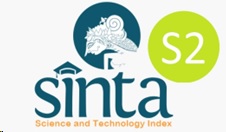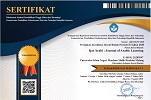Comparative Analysis Of AI And Human Translations Of Qur’anic Legal Verses In Surah Al-Ma’idah
Abstract
Keywords
Full Text:
PDFReferences
Abdul-Ghafour, A. Q. K. M., Awal, N. M., Zainudin, I. S., & Aladdin, A. (2019). The Interplay of Qur'ānic synonymy and polysemy with special reference to Al-asfār and Al-kutub (the books) and their English translations. 3L, Language, Linguistics, Literature, 25(1), 129-143.
Adnan, A. (2024). Critical and Comparative Analysis of the Legal Ruling Verses (Āyāt al-Āḥkām) in the English Translations of the Qur'ān. PhD thesis, University of Exeter.
Ahmed, F. (2023). Semantic Study of the Word Halal Based on Minor and Supreme Derivation. Al-Burhān: Journal of Qurʾān and Sunnah Studies, 7(1), 58-80.
Albalawi, A. F., & Ghafour, A. Q. K. A. (2024). Unravelling Qur'anic Arabic Puns Through AI English Translation and the Art of Human Post-Editing. Ijaz Arabi Journal of Arabic Learning, 7(2), 680-695.
Ali, A. Y. (2001). The Meaning of the Holy Qur'ān: New Edition with Qur'anic Text (Arabic), Revised Translation, Commentary, and Newly Complied Comprehensive Index. 10th ed. Brentwood, Maryland: Amana Publications.
Asnawi, A. R. (2022). Investigating Cohesiveness of QS. Al-Mā’idah: A Review on Michel Cuypers Implementation of Semitic Rhetorical Analysis (SRA). Investigating Cohesiveness of QS. Al-Mā’idah: A Review on Michel Cuypers Implementation of Semitic Rhetorical Analysis (SRA), 23(1), 49-68.
Basalamah, S., & Sadek, G. (2019). Debates around the translation of the Qur’an: Between jurisprudence and translation studies. In The Routledge Handbook of Arabic Translation (pp. 9-26). Routledge.
Edaich, S. (2014). The tolerance in Islamic legal model. Studia Oecumenica, (14), 285-302.
Hidaya, M. S., & Solihin, S. M. (2019). Translatability of the Qur’an: An Analysis of Linguistic and Theological Elements. Islamic Insight, 2(1), 12-36.
Iwanebel, F. Y. (2024). Revisiting the Prohibition of Khamr and Maysir in the Qur’an: An Examination of Surah Al-Mā’idah [5]: 90-91. Revelatia Jurnal Ilmu al-Quran dan Tafsir, 5(1), 1-18.
Mu'awwanah, N. (2018). The Concept of Justice in the System of the Confliction Through Contextualization of Surah al-Mā’ida 44-47 (Application of Abdullah Saeed’s Contextual Approach). Ulumuna, 22(1), 172-203.
Rezai, J., Shahrokhi, S. A., & Karimivala, M. (2021). Quranic-Intellectual Recitation of the Truth of the Religion Perfection, Considering the Necessity of Internal and External Compatibility of the Third Verse of Surah Ma'idah, along with a Critique of Sunni Views. International Journal of Multicultural and Multireligious Understanding, 8(7), 331-343.
Rosa, A. A. (2010). Descriptive translation studies (DTS). Handbook of translation studies, 1, 94-104.
Saeed, A. (2006). Interpreting the Qur'an: towards a contemporary approach (p. 209). Taylor & Francis.
Yusroh, Y., & Rahman, M. Z. A. (2018). Mapping Contemporary Islamic Jurisprudence of Muḥammad Saʻīd al-'Ashmāwī and Muḥammad Shaḥrūr. International Journal of Islamic Studies and Humanities, 1(1), 32.
Al-Jarf, R. (2023). International Journal of Translation and Interpretation Studies Time Metaphors in English and Arabic: Translation Challenges. https://doi.org/10.32996/ijtis
Arifin, Z., Hasan, M. R., & Haqqi, A. R. A. (2022). QAT’I AND ZANNI DEBATE FROM THE PERSPECTIVE OF QUR’ANIC STUDIES. QiST: Journal of Quran and Tafseer Studies, 2(1), 63–67. https://doi.org/10.23917/qist.v2i1.1248
Azizah, N., Basthomi, Y., & Subianto, A. (2021). Syntactic Analysis of Surah Qaf English Translation by Muhammad Taqiudin Al Hilali and Muhammad Muhsin Khan. JoLLA: Journal of Language, Literature, and Arts, 1(2), 239–250. https://doi.org/10.17977/um064v1i22021p239-250
Baidowi, A., Salehudin, A., Mustaqim, A., Qudsy, S. Z., & Hak, N. (2021). Theology of health of quranic pesantren in the time of COVID-19. HTS Teologiese Studies / Theological Studies, 77(4). https://doi.org/10.4102/hts.v77i4.6452
Dahia, I., & Belbacha, M. (2024). International Journal of Linguistics, Literature and Translation Machine-Learning-based English Quranic Translation: An Evaluation of ChatGPT. https://doi.org/10.32996/ijllt
Fajar Affani, S., & Nirwana, A. A. (2024). Sulkhan Fajar Affani, Andri Nirwana AN, Fuadi How Analysis Scopus Database About Islamic Leadership Based on Quranic Studies Since. 7(2). https://doi.org/10.31943/afkarjournal.v7i2.1037
Izzah, N., Ghozali, M., Suhaili Mansor, N., Awang, H., & Yusof, S. M. (2024). AUTOMATED TRANSLATION TOOLS FOR MUALAF: ARTIFICIAL INTELLIGENCE SOLUTIONS FOR ACCESSING ISLAMIC TEXTS AND RESOURCES ACROSS LANGUAGES Creative Commons Attribution 4.0 International. International Journal of Islamic Theology and Civilization E-ISSN, 2(3), 3009–1551. https://doi.org/10.5281/zenodo.13943175
Mukhtar, S., & Sani Abdulkadir, Z. (2023). The Significance of English Language and its Relevance to the Preservation of the Qur’anic Script. 1. https://doi.org/10.59479/jiaheri.v1i001.38
Roodashsty, M., Amin Mozaheb, M., & Ghajarieh, A. (2023). Translation of Culture-Specific Items in Three Chapters of the Holy Quran: The Case Study of Translators with Different L1 Backgrounds. 1(1). https://doi.org/10.30497/ISQH.2023.244736.1005
Tarmizi, S. A., & Saad, S. (2022). Named Entity Recognition For Quranic Text Using Rule Based Approaches. Asia-Pacific Journal of Information Technology and Multimedia, 11(02), 112–122. https://doi.org/10.17576/apjitm-2022-1102-09
Zekkour, H., & Imamuddin, I. (2024). Methods of Understanding the Quran and Hadith from Ancient Times to Modern Times. Journal of Education and Teacher Training Innovation, 2(2), 102–109. https://doi.org/10.61227/jetti.v2i2.112
DOI: https://doi.org/10.18860/ijazarabi.v8i1.28804
Refbacks
Copyright (c) 2025 Hussein Fahim Abdalhussein
License URL: https://creativecommons.org/licenses/by-sa/4.0/













